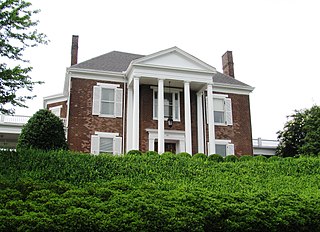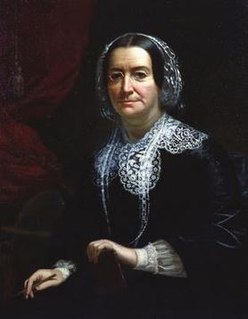
Clarksville is the county seat of Montgomery County, Tennessee, United States. It is the fifth-largest city in the state behind Nashville, Memphis, Knoxville, and Chattanooga. The city had a population of 132,929 at the 2010 census, and an estimated population of 158,146 in 2019.

Sevierville is a city in and the county seat of Sevier County, Tennessee, located in Eastern Tennessee. The population was 14,807 at the 2010 United States Census and 17,117 according to the 2019 census estimate.

The Martin Luther King Jr. National Historical Park consists of several buildings in Atlanta, Georgia, including Martin Luther King Jr.'s boyhood home and the original Ebenezer Baptist Church, the church where King was baptized and both his father Martin Luther King Sr. and he were pastors.
The Mabry Hood House, also known as the Mabry Hood Mansion, was a historic antebellum style home located on the south side of Kingston Pike at the intersection of Mabry Hood Road in Knox County, Tennessee. The vacant home sat in the path of Pellissippi Parkway and was demolished when the construction commenced on the limited access highway in the 1990s.

Knollwood is an antebellum historic house at 6411 Kingston Pike in Knoxville, Tennessee, United States. It is also known as Knollwood Hall, Major Reynolds House, the Tucker Mansion and Bearden Hill. The home is listed on the National Register of Historic Places.

The Mabry–Hazen House is a historic home located on an 8-acre (3.2 ha) site at 1711 Dandridge Avenue in Knoxville, Tennessee, at the crest of Mabry's Hill. Also known as the Evelyn Hazen House or the Joseph Alexander Mabry Jr. House, when constructed in 1858 for Joseph Alexander Mabry II it was named Pine Hill Cottage. The house was in what was then the separate town of East Knoxville. Stylistically, the house exhibits both Italianate and Greek Revival elements. Additions in 1886 increased the size of the first floor. Having operated as a museum since the death of Evelyn Hazen, the house retains its original furniture and family collections, including antique china and crystal with over 2,000 original artifacts on display making it the largest original family collection within America. The house is listed on the National Register of Historic Places.
This is a list of the National Register of Historic Places listings in Knox County, Tennessee.
Joseph Alexander Mabry II was an American folk figure and businessman active primarily in Knoxville, Tennessee, in the mid-nineteenth century. Mabry earned a fortune through land and railroad speculation during the 1850s, and was known throughout the South for his herd of race horses. During the Civil War, Mabry donated a large supply of uniforms and tents to the Confederate Army, and was rewarded with the rank of general. For the remainder of his life, he was thus often referred to by the sobriquet, "General Mabry."

Belmont Mansion, also known as Acklen Hall, and originally known as Belle Monte, Belle Mont or Belmont, is a historic mansion located in Nashville, Tennessee. It was built by Joseph and Adelicia Acklen to serve as the center of their 180-acre summer estate in what was then country outside the city, and featured elaborate gardens and a zoo. They lived much of the rest of the year on her plantations in Louisiana.

The Joseph Wheeler Plantation, commonly known as Pond Spring or the General Joe Wheeler Home, is a historic plantation complex and historic district in the Tennessee River Valley in Wheeler, Alabama. The property contains twelve historically significant structures dating from 1818 to the 1880s. It was added to the National Register of Historic Places on April 13, 1977, due to its association with Joseph Wheeler.

Chilhowee Park is a residential neighborhood in Knoxville, Tennessee, United States, located off Magnolia Avenue in the East Knoxville area. Developed as a streetcar suburb in the 1890s, this neighborhood was initially part of Park City, which was incorporated as a separate city in 1907, and annexed by Knoxville in 1917. Chilhowee Park lies adjacent to one of Knoxville's largest municipal parks, as well as Zoo Knoxville. The neighborhood contains a notable number of early-20th-century houses.

The Clover Bottom Mansion is a historic mansion located in Nashville, Tennessee, United States. It is the home of the Tennessee Historical Commission, the State Historic Preservation Office.

Ashcrest Farm is a historic mansion in Hendersonville, Tennessee, U.S.. Designed in the Classical Revival architectural style, it was built by slaves before the American Civil War and black laborers after the war. The land has been owned by the same family since 1810. Today, it is a horse farm.

Julia A. Tevis was a pioneer educator of women from Kentucky. After teaching for several years in Virginia, she founded the Science Hill Female Academy in Shelbyville and led the institution to gain a national reputation for excellence. Teaching her students math and science, rather than how to be accomplished seamstresses, Tevis prepared young women for colleges.

The Samuel Rexinger House, also known as Archwood, is a historic mansion in Clarksville, Tennessee, U.S.. It is the residence of the president of Austin Peay State University.

Tip Top is a historic mansion in Clarksville, Tennessee. It was built in 1859 for J. P. Williams, a "tobacconist". It was the residence of Governor Malcolm Patterson from 1909 to 1912, until it was purchased by the Trahern family.

The Julius Freed House is a historic house in Trenton, Tennessee. It was built in 1871-1872 for Prussian-born Confederate veteran and Klansman Julius Freed. It is listed on the National Register of Historic Places.

The Alfred A. Robb House is a historic house in Clarksville, Tennessee. It was built in 1859 for Alfred Robb, a graduate of the University of Nashville and lawyer who served on the board of the Masonic College, now known as Austin Peay State University. Robb lived here with his wife, née Mary E. Conrad, and their five children. One of their sons, James E. Bailey, served as a United State Senator from Tennessee from 1877 to 1881.

The Christopher H. Smith House, also known as the Queen of the Cumberland, is a historic house in Clarksville, Tennessee. It was built in the Antebellum era for a tobacco merchant. It is listed on the National Register of Historic Places.

The Henegar House is a historic house in Charleston, Tennessee. Constructed in 1849, it is the oldest remaining brick structure in Bradley County. It was listed on the National Register of Historic Places (NRHP) in 1976.

















